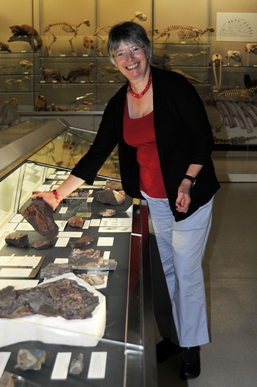
Jennifer Alice Clack, was an English palaeontologist and evolutionary biologist. She specialised in the early evolution of tetrapods, specifically studying the "fish to tetrapod" transition: the origin, evolutionary development and radiation of early tetrapods and their relatives among the lobe-finned fishes. She is best known for her book Gaining Ground: the Origin and Early Evolution of Tetrapods, published in 2002 and written with the layperson in mind.
Romer's gap is an apparent gap in the Paleozoic tetrapod fossil record used in the study of evolutionary biology, which represent periods from which excavators have not yet found relevant fossils. It is named after American paleontologist Alfred Romer, who first recognised it in 1956. Recent discoveries in Scotland are beginning to close this gap in palaeontological knowledge.

Westlothiana is a genus of reptile-like tetrapod that lived about 338 million years ago during the latest part of the Viséan age of the Carboniferous. The genus is known from a single species, Westlothiana lizziae. It is the oldest known uncontroversial tetrapod, closely related to but not an amniote.

Ventastega is an extinct genus of stem tetrapod that lived during the Upper Fammenian of the Late Devonian, approximately 372.2 to 358.9 million years ago. Only one species is known that belongs in the genus, Ventastega curonica, which was described in 1996 after fossils were discovered in 1933 and mistakenly associated with a fish called Polyplocodus wenjukovi. ‘Curonica’ in the species name refers to Curonia, the Latin name for Kurzeme, a region in western Latvia. Ventastega curonica was discovered in two localities in Latvia, and was the first stem tetrapod described in Latvia along with being only the 4th Devonian tetrapodomorph known at the time of description. Based on the morphology of both cranial and post-cranial elements discovered, Ventastega is more primitive than other Devonian tetrapodomorphs including Acanthostega and Ichthyostega, and helps further understanding of the fish-tetrapod transition.

Eucritta is an extinct genus of stem-tetrapod from the Viséan epoch in the Carboniferous period of Scotland. The name of the type and only species, E. melanolimnetes is a homage to the 1954 horror film Creature from the Black Lagoon.

Pederpes is an extinct genus of early Carboniferous stegocephalian, dating from 348 to 347.6 Ma in the Tournaisian age. Pederpes contains one species, P. finneyae, 1 m long.
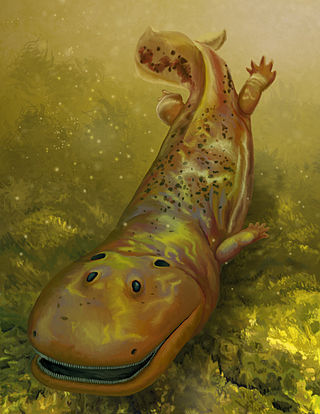
Spathicephalus is an extinct genus of stem tetrapods that lived during the middle of the Carboniferous Period. The genus includes two species: the type species S. mirus from Scotland, which is known from two mostly complete skulls and other cranial material, and the species S. pereger from Nova Scotia, which is known from a single fragment of the skull table. Based on the S. mirus material, the appearance of Spathicephalus is unlike that of any other early tetrapod, with a flattened, square-shaped skull and jaws lined with hundreds of very small chisel-like teeth. However, Spathicephalus shares several anatomical features with a family of stem tetrapods called Baphetidae, leading most paleontologists who have studied the genus to place it within a larger group called Baphetoidea, often as part of its own monotypic family Spathicephalidae. Spathicephalus is thought to have fed on aquatic invertebrates through a combination of suction feeding and filter feeding.
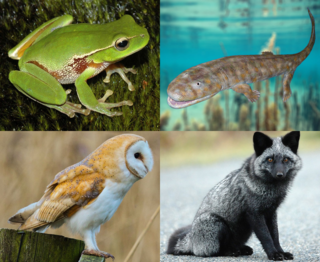
Stegocephali is a clade of vertebrate animals containing all fully limbed tetrapodomorphs. It is equivalent to a broad definition of the superclass Tetrapoda: under this broad definition, the term "tetrapod" applies to any animal descended from the first vertebrate with four limbs each with digits in the extremity (pentadactyly), rather than fins of their sarcopterygian relatives.

Ossinodus is an extinct genus of stem tetrapod. Fossils have been found from the Ducabrook Formation in Queensland, Australia dating back to the middle Visean stage of the Early Carboniferous (Mississippian). It was originally placed within the family Whatcheeriidae, but the absence of an intertemporal bone as suggested by a recent reconstruction of the skull based on fragmentary material may prove it to be stemward of all whatcheeriids.
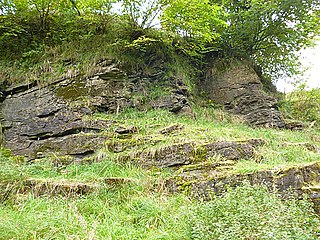
East Kirkton Quarry, or simply East Kirkton, is a former limestone quarry in West Lothian, Scotland, now a renowned fossil site. The quarry is known for terrestrial and freshwater fossils about 335 million years old, from the late Viséan stage of the Mississippian subperiod. The quarry is a 200-meter-long (~650 ft) depression located in the town of Bathgate. Geographically, it sits at the Bathgate Hills near the center of the Midland Valley, a fossil-rich region of southeast Scotland. The site is dominated by volcanic tuff, limestone, and silica deposits of large freshwater lakes associated with hot springs and local basaltic (high-iron) volcanism. Three geological intervals are exposed: the East Kirkton Limestone (oldest), Little Cliff Shale (middle), and Geikie Tuff (youngest).

Eldeceeon is an extinct genus of reptiliomorph from the Mississippian of Scotland. It is known from two fossil specimens found within the Viséan-age East Kirkton Quarry in West Lothian. The type and only species, E. rolfei, was named in 1994. Eldeceeon is thought to be closely related to embolomeres, but it has several distinguishing features including long limbs and a short trunk. Initially known from two crushed partial skeletons, additional specimens have been reported by Ruta & Clack (2006). Eldeceeon was redescribed by Ruta, Clack, & Smithson (2020). The redescription supported affinities with Silvanerpeton, reconstructed a skull with larger eyes and a shorter snout, and emphasized potential correlations for an enlarge puboischiofemoralis internus 2 muscle.

Occidens is an extinct genus of stem tetrapod from the Early Carboniferous (Tournaisian) Altagoan Formation of Northern Ireland. It is known from a single type species, Occidens portlocki, named in 2004 on the basis of a left lower jaw described by British geologist Joseph Ellison Portlock in 1843.

The Ballagan Formation is a geologic formation in Scotland and England. It preserves fossils dating back to the early part of the Carboniferous period. Its name comes from the "Ballagan Beds" of Ballagan Glen, near Strathblane, which has a good example of this geological formation.
Aytonerpeton is an extinct genus of stem-tetrapod from the Ballagan Formation of Scotland. It was one of five new genera of early limbed vertebrates from the Ballagan Formation described by Clack et al. in 2016. These vertebrates were among the only known in the world from a period of time known as Romer's gap. Romer's gap, which spans most of the Mississippian age of the Carboniferous, is characterized by a comparative rarity of tetrapod and stem-tetrapod fossils compared to the periods of time directly older and younger than it. However, Aytonerpeton and other Ballagan stem-tetrapods help to close in this gap in the vertebrate fossil record.
Eobaphetes is an extinct genus of embolomere which likely lived in the Pennsylvanian of Kansas. The genus is based on several skull and jaw fragments of a single individual. They were originally described under the species Erpetosuchus kansasensis, but this was later changed to Eobaphetes kansasensis when it was determined that Erpetosuchus was preoccupied by a Triassic reptile.
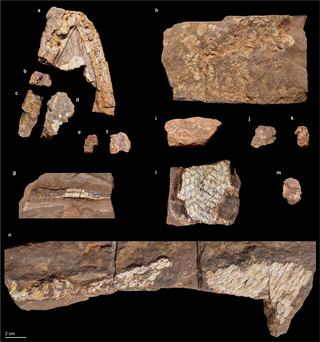
Qikiqtania is an extinct genus of elpistostegalian tetrapodomorph from the Late Devonian Fram Formation of Nunavut, Canada. The genus contains a single species, Q. wakei, known from a partial skeleton. Analysis of the fin bones suggests that Qikiqtania was well-suited to swimming, and likely incapable of walking or supporting itself out of the water, as has been suggested for the closely related Tiktaalik.
Diploradus is an extinct genus of four-limbed stem-tetrapod from the Mississippian (mid-Tournaisian) of Scotland. It contains a single species, Diploradus austiumensis, based on an incomplete skull and jaw fragments from the Ballagan Formation at Burnmouth. The most complete part of the specimen, the lower jaw, was about 3.0 cm in length and possessed several rows of small, numerous teeth. It likely represents a juvenile animal. Diploradus was described in a 2016 study which was devised to fill in the tetrapod and stem-tetrapod faunas of Romer's gap, an interval of the early Carboniferous with few vertebrate fossils. It was one of five new genera named in this study, along with Aytonerpeton, Koilops, Ossirarus, and Perittodus.
Koilops is an extinct genus of four-limbed stem-tetrapod from the Mississippian (mid-Tournaisian) of Scotland. It contains a single species, Koilops herma, based on a mold of an 8.0 cm -long skull from the Ballagan Formation. A phylogenetic analysis in its original description places Koilops as a close relative of Tulerpeton and colosteids. Koilops was described in a 2016 study which was devised to fill in the tetrapod and stem-tetrapod faunas of Romer's gap, an interval of the early Carboniferous with few vertebrate fossils. It was one of five new genera named in this study, along with Aytonerpeton, Diploradus, Ossirarus, and Perittodus.
Perittodus is an extinct genus of four-limbed stem-tetrapod from the Mississippian (mid-Tournaisian) of Scotland. It contains a single species, Perittodus apsconditus, based on disarticulated skull and postcranial bones from the Ballagan Formation. The lower jaw of the holotype specimen was about 6.8 cm in length and had a pattern of dentition similar to the Devonian taxon Ymeria. Perittodus was described in a 2016 study which was devised to fill in the tetrapod and stem-tetrapod faunas of Romer's gap, an interval of the early Carboniferous with few vertebrate fossils. It was one of five new genera named in this study, along with Aytonerpeton, Diploradus, Koilops, and Ossirarus.
Mesanerpeton is an extinct genus of four-limbed stem-tetrapod from the Mississippian (Tournaisian) of Scotland. It contains a single species, Mesanerpeton woodi, who based on a disarticulated specimen including a clavicle, vertebrae, and forelimb bones from the Ballagan Formation. The vertebrae are poorly-ossified and similar to Crassigyrinus, but the forelimb was robust. The shape and level of torsion present in the humerus are intermediate between Devonian stem-tetrapods and later Carboniferous tetrapods. This transitional condition, and the associated rerouting of the brachial artery and median nerve, may indicate that Mesanerpeton had a higher stride length and more efficient locomotion on land compared to its predecessors.





















